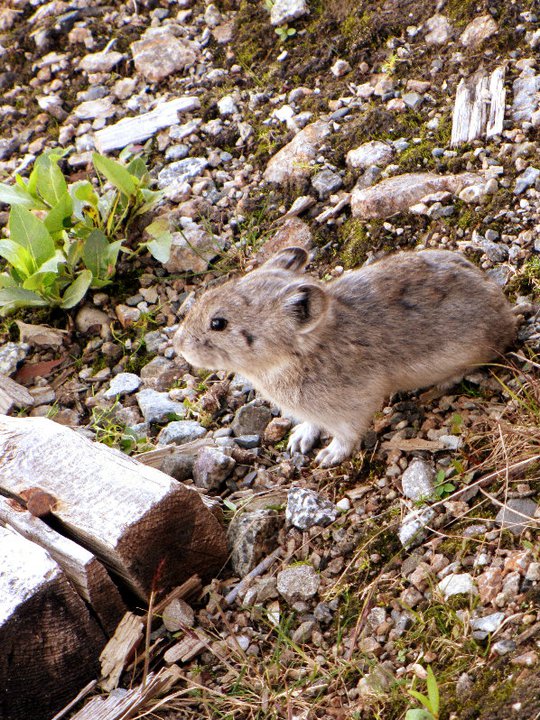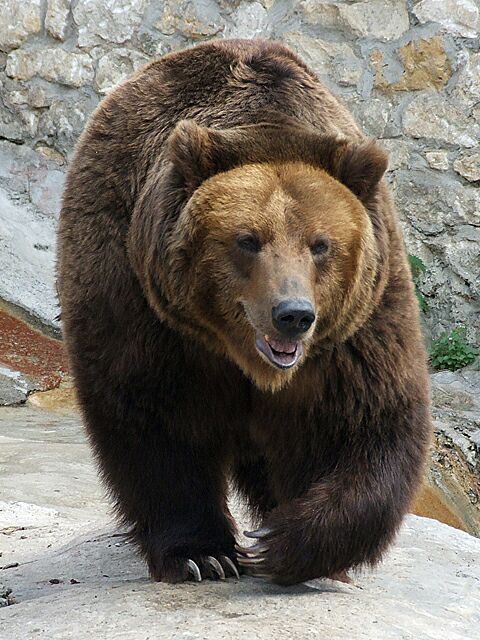|
Pallas's Pika
Pallas's pika (''Ochotona pallasi''), also known as the Mongolian pika, is a species of small mammals in the pika family, Ochotonidae. It is found mainly in the mountains of western Mongolia. Description Pallas's pika can range from anywhere between in weight and can grow up to long. Pallas's pikas have round bodies, very short limbs, and small rounded ears. They will also have different pelage coloration depending on the time of the year. They become lighter in the summer and much darker in the winter. Ecology Distribution and habitat ''O. p. pallasi'' can be geographically separated from the other three subspecies. ''O. p. pallasi'' is largely distributed in Kazakhstan and the other large group ''O. p. pricei'', are distributed along Mongolia and bordering territories. The range for both these groups extends all the way between the Betpak Dala Desert located in Kazakhastan to the Helan Shan Range. The remaining two, which have been little-studied, ''O. p. argentata'' colle ... [...More Info...] [...Related Items...] OR: [Wikipedia] [Google] [Baidu] |
John Edward Gray
John Edward Gray, FRS (12 February 1800 – 7 March 1875) was a British zoologist. He was the elder brother of zoologist George Robert Gray and son of the pharmacologist and botanist Samuel Frederick Gray (1766–1828). The same is used for a zoological name. Gray was keeper of zoology at the British Museum in London from 1840 until Christmas 1874, before the natural history holdings were split off to the Natural History Museum. He published several catalogues of the museum collections that included comprehensive discussions of animal groups and descriptions of new species. He improved the zoological collections to make them amongst the best in the world. Biography Gray was born in Walsall, but his family soon moved to London, where Gray studied medicine. He assisted his father in writing ''The Natural Arrangement of British Plants'' (1821). After being blackballed by the Linnean Society of London, Gray shifted his interest from botany to zoology. He began his zoologica ... [...More Info...] [...Related Items...] OR: [Wikipedia] [Google] [Baidu] |
Kazakh Pika
Kazakh, Qazaq or Kazakhstani may refer to: * Someone or something related to Kazakhstan *Kazakhs, an ethnic group *Kazakh language *The Kazakh Khanate *Kazakh cuisine *Qazakh Rayon, Azerbaijan *Qazax, Azerbaijan *Kazakh Uyezd, administrative district of Elisabethpol Governorate during Russian rule in Azerbaijan *Khazak, Iran, a village in Fars Province, Iran See also * Cossack (other) * Kazaky, Ukrainian pop band * Kazak (other) Kazak may refer to: Places * Kazak, Bulgaria, a village * Kazak, Iran, a village in Fars Province * Kazak Island, Antarctica * 6110 Kazak, a main-belt asteroid Other uses * Cossacks, a Slavic-speaking social group of Eastern Europe * Kazakhs, a ... {{disambig, geo Language and nationality disambiguation pages ... [...More Info...] [...Related Items...] OR: [Wikipedia] [Google] [Baidu] |
Mongolia
Mongolia; Mongolian script: , , ; lit. "Mongol Nation" or "State of Mongolia" () is a landlocked country in East Asia, bordered by Russia to the north and China to the south. It covers an area of , with a population of just 3.3 million, making it the world's most sparsely populated sovereign nation. Mongolia is the world's largest landlocked country that does not border a closed sea, and much of its area is covered by grassy steppe, with mountains to the north and west and the Gobi Desert to the south. Ulaanbaatar, the capital and largest city, is home to roughly half of the country's population. The territory of modern-day Mongolia has been ruled by various nomadic empires, including the Xiongnu, the Xianbei, the Rouran, the First Turkic Khaganate, and others. In 1206, Genghis Khan founded the Mongol Empire, which became the largest contiguous land empire in history. His grandson Kublai Khan conquered China proper and established the Yuan dynasty. After the co ... [...More Info...] [...Related Items...] OR: [Wikipedia] [Google] [Baidu] |
Herbivore
A herbivore is an animal anatomically and physiologically adapted to eating plant material, for example foliage or marine algae, for the main component of its diet. As a result of their plant diet, herbivorous animals typically have mouthparts adapted to rasping or grinding. Horses and other herbivores have wide flat teeth that are adapted to grinding grass, tree bark, and other tough plant material. A large percentage of herbivores have mutualistic gut flora that help them digest plant matter, which is more difficult to digest than animal prey. This flora is made up of cellulose-digesting protozoans or bacteria. Etymology Herbivore is the anglicized form of a modern Latin coinage, ''herbivora'', cited in Charles Lyell's 1830 ''Principles of Geology''.J.A. Simpson and E.S.C. Weiner, eds. (2000) ''The Oxford English Dictionary'', vol. 8, p. 155. Richard Owen employed the anglicized term in an 1854 work on fossil teeth and skeletons. ''Herbivora'' is derived from Latin ''herba' ... [...More Info...] [...Related Items...] OR: [Wikipedia] [Google] [Baidu] |
Seed Dispersal
In Spermatophyte plants, seed dispersal is the movement, spread or transport of seeds away from the parent plant. Plants have limited mobility and rely upon a variety of dispersal vectors to transport their seeds, including both abiotic vectors, such as the wind, and living ( biotic) vectors such as birds. Seeds can be dispersed away from the parent plant individually or collectively, as well as dispersed in both space and time. The patterns of seed dispersal are determined in large part by the dispersal mechanism and this has important implications for the demographic and genetic structure of plant populations, as well as migration patterns and species interactions. There are five main modes of seed dispersal: gravity, wind, ballistic, water, and by animals. Some plants are serotinous and only disperse their seeds in response to an environmental stimulus. These modes are typically inferred based on adaptations, such as wings or fleshy fruit. However, this simplified view may ignor ... [...More Info...] [...Related Items...] OR: [Wikipedia] [Google] [Baidu] |
Endangered
An endangered species is a species that is very likely to become extinct in the near future, either worldwide or in a particular political jurisdiction. Endangered species may be at risk due to factors such as habitat loss, poaching and invasive species. The International Union for Conservation of Nature (IUCN) Red List lists the global conservation status of many species, and various other agencies assess the status of species within particular areas. Many nations have laws that protect conservation-reliant species which, for example, forbid hunting, restrict land development, or create protected areas. Some endangered species are the target of extensive conservation efforts such as captive breeding and habitat restoration. Human activity is a significant cause in causing some species to become endangered. Conservation status The conservation status of a species indicates the likelihood that it will become extinct. Multiple factors are considered when assessing the s ... [...More Info...] [...Related Items...] OR: [Wikipedia] [Google] [Baidu] |
Pikas
A pika ( or ; archaically spelled pica) is a small, mountain-dwelling mammal found in Asia and North America. With short limbs, very round body, an even coat of fur, and no external tail, they resemble their close relative, the rabbit, but with short, rounded ears. The large-eared pika of the Himalayas and nearby mountains is found at heights of more than , among the highest of any mammal. Pikas prefer rocky slopes and graze on a range of plants, mostly grasses, flowers and young stems. In the autumn they pull hay, soft twigs and other stores of food into their burrows to eat during the long, cold winter. The pika is also known as the whistling hare because of its high-pitched alarm call when diving into its burrow. The name ‘pika’ appears to be derived from the Tungus ''piika'', and the scientific name ''Ochotona'' is from the Mongolian word ''ogutun-a, оготно'', which means pika. It is used for any member of the Ochotonidae, a family within the order of lagomo ... [...More Info...] [...Related Items...] OR: [Wikipedia] [Google] [Baidu] |
Mammals Of China
This is a list of the mammal species recorded in China. There are 495 mammal species in China, of which thirteen are critically endangered, twenty-four are endangered, forty-seven are vulnerable, and seven are near threatened. One of the species listed for China can no longer be found in the wild. The following tags are used to highlight each species' conservation status as assessed by the International Union for Conservation of Nature: Some species were assessed using an earlier set of criteria. Species assessed using this system have the following instead of near threatened and least concern categories: Order: Sirenia (manatees and dugongs) Sirenia is an order of fully aquatic, herbivorous mammals that inhabit rivers, estuaries, coastal marine waters, swamps, and marine wetlands. All four species are endangered. *Family: Dugongidae **Genus: ''Dugong'' ***Dugong, ''D. dugon'' Order: Proboscidea (elephants) The elephants comprise three living species and are the larges ... [...More Info...] [...Related Items...] OR: [Wikipedia] [Google] [Baidu] |
Mammals Of Mongolia
This is a list of the naturally occurring mammal species recorded in Mongolia. There are 121 mammal species in Mongolia, of which two are critically endangered, four are endangered, nine are vulnerable, and six are near threatened. The following tags are used to highlight each species' conservation status as assessed by the International Union for Conservation of Nature: Some species were assessed using an earlier set of criteria. Species assessed using this system have the following instead of near threatened and least concern categories: Order: Artiodactyla (even-toed ungulates) ---- The even-toed ungulates are ungulates whose weight is borne about equally by the third and fourth toes, rather than mostly or entirely by the third as in perissodactyls. There are about 220 artiodactyl species, including many that are of great economic importance to humans. *Family: Bovidae (cattle, antelope, sheep, goats) **Subfamily: Antilopinae ***Genus: ''Gazella'' **** Goitered gazelle, '' ... [...More Info...] [...Related Items...] OR: [Wikipedia] [Google] [Baidu] |
Mammals Of Russia
This is a list of the mammal species recorded in Russia. There are 266 mammal species in Russia, of which five are critically endangered, thirteen are endangered, twenty-six are vulnerable, and six are near threatened. One of the species listed for Russia is extinct and one can no longer be found in the wild. All the mammals of Russia are in the subclass Theria and infraclass Eutheria, being all placental. The following tags are used to highlight each species' conservation status as assessed by the International Union for Conservation of Nature: Order: Sirenia (manatees and dugongs) Sirenia is an order of fully aquatic, herbivorous mammals that inhabit rivers, estuaries, coastal marine waters, swamps, and marine wetlands. All four species are endangered. *Family: Dugongidae **Genus: ''Hydrodamalis'' *** Steller's sea cow, ''H. gigas'' Order: Rodentia (rodents) Rodents make up the largest order of mammals, with over 40% of mammalian species. They have two incisors in ... [...More Info...] [...Related Items...] OR: [Wikipedia] [Google] [Baidu] |

_grazing_-_20050809.jpg)




